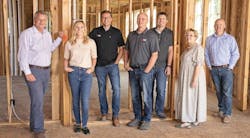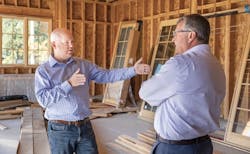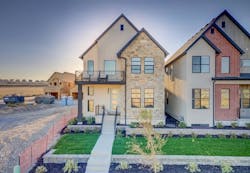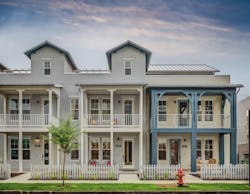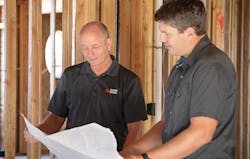Builder of the Year Ivory Homes' Innovation Agenda
When Clark Ivory returned with his family to Salt Lake City from a three-year church mission in the eastern European countries of Moldova and Romania in 2017, he could have easily allowed Ivory Homes, the company founded by his father, Ellis, almost 50 years earlier, to continue without him.
After all, during his absence, Ivory Homes had strengthened its place as Utah’s No. 1 home builder in building permits and construction value, scaring off every large-volume, multistate production operation that dared enter Ivory’s Wasatch Mountain lair. Maybe now was the right time to step back, to perhaps even cash out.
Instead, Clark Ivory reassumed his CEO duties and set a bold, uncharted course to diversify the company’s successful semi-custom, move-up home legacy to include affordable housing for an increasing underserved segment of buyers.
“Clark came home and he had his thinking cap on,” his wife, Christine, recalls. “He was like, ‘I can really do something because there are so many capable people who are willing to collaborate and innovate.’” The success of that strategy, as well as a sincere and long-standing commitment to industry innovation, community service, the environment, and collaboration with local government—the upshot of which is a 90% customer satisfaction rating and $620.3 million in revenue from 1,323 closings last year—are what has earned Ivory Homes our Builder of the Year honor for 2021.
RELATED
- See past Builder of the Year winners
- Business Success: Easy as 1, 2, 3?
- Design Within Reach—Exploring Attainable Housing Options
Ivory Homes' Leadership: Seeking a Path Forward ... and Outward
Having witnessed income and social class inequities entrenched by corruption on their European mission, and a system in which government officials and business entrepreneurs rarely collaborate to solve civic and social problems, the Ivorys recognized the seeds of similar dynamics in their own backyard.
Sure, Utah had one of the strongest economies in the country, but its population growth was being fueled largely by Silicon Valley companies setting up shop in Salt Lake City or acquiring local tech firms as satellite offices, while housing production was increasingly hindered by regulatory barriers.
Not only did that influx of people drive up local housing demand, but high-paying jobs and tightening supply boosted prices, too. If those trends continued, Clark reckoned housing affordability in the Salt Lake metro area would follow the same path as California’s Silicon Valley, potentially creating an estimated shortage of 50,845 housing units in the Salt Lake market by 2044, according to a 2018 study by the University of Utah’s Kem C. Gardner Policy Institute. “We had to somehow get involved and see what we could do to deal with this issue and how we could contribute,” he says. “I knew we couldn’t be the same builder we’d always been.”
But addressing the future needs of housing affordability—namely, expanding its product mix and pool of buyers, retooling its well-known, long-standing brand, and managing NIMBYism against its vision—would not happen overnight. Or alone. Ivory knew the big-picture problem was way over the head of one person or company to achieve a widespread, lasting impact; it called for an army to navigate the maze of barriers that hinder entry-level homes from penciling out on a profit and loss report and gaining community support. So he rallied other chief executives and employers to join the newly formed Housing Gap Coalition through the local Chamber of Commerce—and not just builders and developers, but also insurance companies, bankers, and a variety of others. “The way you get rid of the housing shortage is to have everybody thinking they need to do something about it,” Clark says. “They have to pitch in and get involved because they all realize that we won’t have sustainable economic growth if housing is too expensive here.”
The other front was for the real estate community to stop playing defense against entitlement processes, development standards, and zoning procedures that varied widely from city to city within the Salt Lake Valley.
As early as 2006, Ivory Development president Chris Gamvroulas began reaching out to other builders, developers, and associations representing real estate agents and landlords to collaborate through the Utah Property Rights Coalition. “We don’t just focus on land use for land use’s sake, or for profit’s sake,” says Gamvroulas, who also is a principal and board member for the Coalition. “We’re talking about the cost inputs that go into housing and putting some bumpers around what cities can do relative to impact and development fees.”
The group’s mantra is to make friends, not enemies, in city halls and the state capitol. Working with the Utah League of Cities and Towns and with state and municipal officials, the Utah Property Rights Coalition has racked up a litany of small wins during the past 15 years, influencing and helping pass 50 consensus bills regarding land use and the development process.
The group also established an expectation among state and local officials that if they get out of line, the real estate community is going to fight back, not sit back and take it. Just ask the local sewer district sued by the Coalition that eventually refunded $35 million of overcharged impact fees.
Ivory Homes Redesigns the Future
Even with support from the larger business community and incremental progress with state and municipal agencies to better enable attainable housing for the middle and working classes, Ivory Homes didn’t have a product to sell to that segment.
But that didn’t stop the development team from acquiring land and platting it for tighter lots. “We were creating subdivisions with lots knowing that the homes team had to catch up to deliver on them,” says Bryon Prince, VP at Ivory Development. “That’s kind of scary because when you pave the roads, it’s pretty baked in, so there’s this hope that the rest of our team would get there with product.”
Since Clark began working with his father in 1988, Ivory Homes resisted changing its product, opting instead for consistency and small refinements to its Signature Series of second move-up homes.
In its initial effort to pivot to affordability, an in-house team of architects, designers, and operations staff streamlined the Signature Series into the relatively less expensive Collection Series, primarily by prepackaging design options and offering fewer customization options for buyers.
Then Ivory stretched further, engaging consultants such as Woodley Architectural Group and seeking input from trade partners to help value-engineer all-new product development—ultimately creating the backbone of the Utah Workforce Housing Priority, led by the Cottages, a series of single-family detached homes starting at 1,451 square feet on two levels with yards and two-car garages ... and price points well below Ivory’s standard fare.
Since launching that series in February 2018, Ivory has built and sold more than 450 Cottages homes at discounted prices for first responders, military families, construction trades and supplier employees, nurses, and teachers. Almost two dozen cities and towns have so far benefited from the workforce housing initiative, but an enclave of nine Cottages built in South Jordan, less than 20 miles south of Salt Lake City’s downtown core, is the poster child for what happens when a builder and a community proactively come together.
For that tight neighborhood of houses, Ivory Homes showed town leaders its Cottages portfolio and asked for help in enabling city employees and frontline workers living in South Jordan—who otherwise would lose any bidding war for a house priced in the $300,000s—to achieve homeownership.
South Jordan responded by rezoning a parcel of land to allow for more density and kicked in $900,000 for infrastructure development to get prices $100,000 below market value. Town officials also helped subdue NIMBY-prone neighbors by showing them what the development would look like, including a complete landscaping package that uses 60% less water than traditional yards. That amenity, along with water conservation measures, became a standard feature for all Ivory Homes in 2020.
Enabling Alternatives for Greater Housing Affordability
Ivory’s approaches to affordability dovetailed with initiatives by Utah legislators, who tasked municipalities to devise five-year moderate-income and attainable housing strategies to meet the current and future needs of their residents.
Lawmakers also prescribed a uniform set of rules statewide for the construction of accessory dwelling units (ADUs), while restricting municipalities from adding any conditions on the construction of ADUs within the existing footprint of a lot’s primary structure. But some cities and towns have been slow to adopt these new policies, chiefly because local elected officials are the ones who face NIMBY opposition to any proposal that increases density in single-family neighborhoods or because of the possibility that a property could be rented out as a fraternity house. (The reality is that many Salt Lake County households double up under one roof or supplement their income by renting out a basement, bedroom, or garage because of the dearth of affordable living space.)
One municipality that bucked that opposition was Midvale, a town of more than 34,000 in the center of the Salt Lake Valley. Its leaders gave Ivory Homes the green light to build three prototype houses on a brownfield corner lot of less than half an acre, with accessory dwelling units integrated either above the garage or into the ground floor.
The Pines at Midvale are multifamily units that look like single-family homes. Each building has its own garage, which dispels any objections about parking congestion spillover onto the streets, and features a 600-square-foot apartment with a separate entrance.
The plans appeal to a variety of household formations, from those with adult children moving back home, an elderly parent who needs care and wants closer proximity to family, or a single tech worker who wants an income-generating rental.
Ivory Homes intends to use The Pines to show other cities that ADUs planned with new construction can fit cohesively in the community, whether as an infill project or as part of a master plan, without creating overcrowding or inciting opposition. “The biggest solution to land affordability is density, and for some that is a four-letter word,” says Peter Gamvroulas, a project manager at Ivory Development. “But there are ways to do it smart and ways to do it at scale. It doesn’t always have to be a high-rise apartment.”
The Prize of Innovation
The genesis for The Pines at Midvale was The Alley Flat Initiative (TAFI), a group based in Austin, Texas, that Clark Ivory and his daughter Abby, managing director of Ivory Innovations, visited in 2019 as a candidate for the annual Ivory Prize program.
A winner in the Policy & Regulatory Reform category, TAFI led the zoning changes in Austin that allowed dwelling space in underutilized alleys behind existing homes by tucking an alley flat, or ADU, on the back of the lot facing the alley. TAFI also offered a one-stop shop to help homeowners finance, build, and rent out their ADU.
“You hear everyone talk about this huge national housing shortage all of the time, but it’s really nice to come in and say hey, why don’t we focus on the solution?” Abby says. “Let’s talk about how we can spur innovation, creativity, and different things that just haven’t happened in this industry.”
The Ivory Prize debuted in September 2018 as a way to tap a wide variety of innovative ideas for construction and design, finance, and regulatory reform nationwide. The award is overseen by Ivory Innovations, a private operating foundation separate from Ivory Homes, and has vetted more than 660 entries to share an annual $200,000 purse funded by the Ivorys’ family foundation.
“What we’re looking for are innovative ideas that have the opportunity to scale and be picked up by different markets, and we want to support them,” Abby says.
Each year, a team of eight college interns is commissioned by Ivory Innovations to conduct research, including traveling and interviews, with prospective candidates. Submissions also come from about 30 University of Utah students enrolled in the Housing Affordability Lab co-taught by Abby, who currently serves as director of strategic projects at the university’s business school after a stint as a social impact investment advisor to companies and high net-worth clients.
Those student entries also are reviewed by the interns, who hone down their research to about 150 candidates before an advisory board—Chris Herbert from the Joint Center for Housing Studies of Harvard University; Ryan Smith from the School of Design and Construction at Washington State University; Laurie Goodman from the Urban Institute; Carol Galante from the University of California, Berkeley; and Kent Colton, chair of the Ivory Innovations advisory board and former National Association of Home Builders CEO—pick the top 25, then the top 10, before the three category winners are selected in April.
The prize generates ideas Ivory Homes actively applies to its own operations. For example, the builder’s mortgage company, Momentum Loans, is working out how to use potential rent revenue from an ADU to help folks qualify for a mortgage loan—a financing model inspired by Accelerating ADUs, one of the 2021 top 10 finalists.
Meanwhile, Ivory’s Apartment Homes brand, which operates more than 3,000 units, is trying out a fin-tech solution proposed by Rhino, a 2020 prize winner. The arrangement gives renters the option to buy an insurance policy at $4 to $7 per month in lieu of a more expensive up-front security deposit, helping them save and more easily qualify for a home mortgage loan.
Ivory Homes also is evaluating whether the logistics and materials from BamCore—a 2021 Ivory Prize winner for its engineered bamboo wall panels and other building components—can serve as a workable, sustainable framing alternative.
RELATED
Ivory is taking on innovations from outside the company, too, pairing faculty at the University of Utah with Landed, a personal finance company that provides part of a down payment for “essential professionals” as a private equity partner, a model that earned it a 2019 Ivory Prize.
A by-product of all of this innovation—not just from the winners, but all of the research behind the program—has made Ivory Innovations a resource for municipalities and other parties looking for ideas and potential providers of housing solutions. “We play this interesting role where we start connecting people, which I think is so needed,” Abby says.
Those that have reached out include Anchorage, Alaska, which sought help managing a growing local homeless population spurred by the pandemic, and Lava Hot Springs, Idaho, which wants to provide incentives for builders to replenish its housing stock after most of it was bought up by “tech nomads” during the last 20 months.
Evolving Sustainability
Before Ivory Homes diversified its product portfolio, the builder had already differentiated itself by making an optional energy-efficiency package standard in all of its homes.
The builder’s evolution to “green” its product was gradual, starting in earnest in 2013, but with the seeds planted in a road map Clark Ivory spelled out to the company before the Great Recession. The “Little I Book” (as in, “I” for Ivory) proclaimed Ivory Homes’ five P’s (or principles), including Planet, translating to a commitment to resource conservation and reducing operating costs for its homebuyers.
Today, Ivory’s homes average a Home Energy Rating System (HERS) score of 53 (on a scale of 100, the lower the better) compared with a HERS-58 average rating nationally and HERS-55 rating among all Utah builders, according to data reported by the Residential Energy Services Network (RESNET), which manages the HERS program.
The builder attributes its HERS ratings to standard features such as 2-by-6 framed walls with R-23 blown-in insulation, higher efficiency furnaces, MERV-11 air filtration, and low-E windows—all of which, and more, help homeowners save an average of $1,200 annually on utility bills compared with homes built to code-minimum standards. Also, starting in 2020, every home is pre-wired for an electric vehicle charging outlet.
Making those features standard “didn’t necessarily close a sale, get a higher appraisal, or make us more money,” Prince says, “but it shows our commitment to the market and to the greater community, and has helped us build a brand as a sustainable builder.”
Then there’s the Verde Collection, a “science experiment” where one of the four units achieves a HERS-41 rating—before adding any renewable on-site energy source. That home has a dual-fuel heat pump, R-59 foam insulation in the ceilings, R-28 perimeter walls, and a tankless water heater, among other progressive, energy-reducing features. The next Verde Collection house will have a rooftop solar array and could be a certified Net Zero Energy Home by the U.S. Department of Energy.
All four homes have been testing labs for various products and systems to find out what works and can be scaled for production home building. “We’re a careful innovator,” says Ivory purchasing manager Jeff Rogers. Local utilities, he points out, put a lot of pressure on builders to help reduce energy use. “We just want to make sure it’s done the right way, so we’re methodical in how we roll it out.”
Ivory Homes Is Thinking Global, Staying Local
Clark Ivory has seen too many local builders around the country that have dominated a market ultimately sell out, usually to a cash-rich national or large regional operation looking to expand their footprint and profit base. It’s not a scenario he likes to see, much less participate in. “Big nationals have asked us if they could buy us, and we’ve said no so quickly each time that they don’t ask anymore,” he says.
His passion for seeing local home builders succeed and sustain is part of the DNA that drives his company. “Local home builders are vital to our industry. They’re the ones that are going to figure out how to work with policy makers, legislators, and with cities,” Clark says. “They help run the housing commission and the home builders associations. They’re the ones that have been in it for decades, see the problems, and care, and they’re the ones continually reinvesting in their community.”
Another reason he and Christine avoided any thoughts of cashing out after coming home from their mission trip is that they had no interest in allowing a national builder to “dilute the impact” Ivory Homes has established in Salt Lake City. That impact can be seen in the company’s long history of charitable giving, planting more than 30,000 trees (and counting) across the valley, driving down the HERS scores of its homes, and working diligently and patiently to affect government policies in such a way as to strike a balance between housing affordability and community sustainability.
It’s also about Ivory Homes taking care of its people, such as giving all 250 Ivory Homes team members $500 in immediate assistance at the beginning of the pandemic to help them find daycare or buy a laptop for home schooling, and providing a $6,000 bonus to every full-time employee that October for working through a rough time for the industry and the community. The company also connected 150 members of its trade base with lawyers and certified public accountants to help them apply for federal Paycheck Protection Program loans during the early months of COVID-19.
RELATED: How Small and Medium-Size Builders Can Prevail
In addition, Clark and Christine donate 30% of the company’s annual profit to the Ivory Foundation, which since its inception in 2003 has awarded scholarships, mentoring, and internships to more than 10,000 students. The couple also helped launch the nonprofit Utah Housing Preservation Fund to purchase and rehab about 4,000 affordable units to help stabilize rental rates and has partnered with various government and local advocacy groups to respond to the needs of individuals and families who are one illness, layoff, or car repair away from falling into a crisis.
“We survived, and now we’re very prosperous, but we’re not going to sell out,” Clark says. “We’re here for the long haul, and whoever is the next generation of leaders or management at Ivory Homes will only have that opportunity if they buy into the mission, which is to continue to be the No. 1 builder in Utah and the No. 1 local builder in the United States.”
Solving Affordability With Gamification
Of all the programs Ivory Innovations supports, from the annual Ivory Prize to serving as a national resource of progressive ideas to solve critical housing issues, its annual Hack-A-House competition arguably has the most potential to affect housing affordability, and no doubt has the best moniker.
The 2021 version of the 24-hour gamification for college students attracted 65 teams from 30 colleges and universities to compete for $13,000 in total prize money.
The goal—within that one-day window—is to find solutions (or “hacks”) that can bring the cost of housing down to 30% or less of a market’s median income.
“There hasn’t been a lot of innovation in housing construction since World War II, compared with other industries, so one of the best areas we can look at is going to the next generation of students,” says Dylan Empey, program coordinator for Ivory Innovations. “They tend to think about things on a very progressive and forward-thinking level.”
Among past Hack-A-House winners, Ivory Innovations is supporting Kit Switch, a startup by a group of Stanford University students that designs a kit of wall panels and building components for converting vacant commercial buildings into housing.
Ivory Homes' Differentiating Factor: Playing Ahead
“One thing that differentiates Ivory Homes is our ability to stay ahead by maintaining our production lots at a consistent level,” says Chris Gamvroulas, president of Ivory Development.
Builders that are laser-focused on one or two master planned communities already in the works, he says, typically neglect backfilling their land inventory fast enough. “Even during the [2006-07] downturn,” Gamvroulas says, “we were bringing out product we knew would sell.”
That’s because Clark Ivory saw the downturn coming. In 2006, as a director of the Salt Lake City branch of the San Francisco Federal Reserve Board, he toured new housing communities in Phoenix and Las Vegas that were rife with vacant houses owned by investors hoping to turn them over at a quick and hefty profit.
He even wrote a white paper voicing his concerns to Janet Yellen (currently the U.S. Secretary of the Treasury), who at the time was president of the Federal Reserve Bank of San Francisco, warning that the housing market was oversupplied with spec homes and was on the verge of collapse.
He also told other builders, suppliers, and trades—in fact, anyone who would listen—to scale back and pay down their debt, while he pulled back Ivory Homes to build only pre-sold homes and townhouses and refused to sell to speculators.
When the Great Recession ensued, builders that didn’t heed his warnings (read: almost all of them) were forced to dump their land holdings, allowing Ivory—flush with cash—to scoop up bargains.
Today the company owns or controls almost 18,000 lots in Utah and already is doing land planning for 2025.
Editorial director Rich Binsacca and executive editor Denise Dersin also contributed to this story.
About the Author

Mike Beirne
Mike is the senior editor of Pro Builder and Custom Builder magazines. A two-time Jesse H. Neal Award winner, Mike has nearly 30 years of journalism experience plus numerous news and feature writing awards, including honors from the Society of Professional Journalists, the American Society of Business Press Editors, and the National Association of Real Estate Editors. He also operated a masonry restoration business for more than two decades. [email protected]


